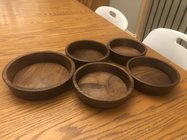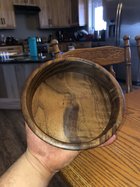Wow, I tell you something...couple days go by without checking the forum and a person can get behind REAL quick!!!
Hi Sheldon, as has been mentioned, those are some really nice pieces, and your consistency is great! I can't offer any further help on pricing than has already been provided to you. Knowing your market and the importance of form is a learning curve that can be different for everyone.
The only point I will add is don't fall into the trap of pricing your work as if you, or your family were going to buy it.
(Warning: unnecessary background story ahead!)
I come from a quite frugal (cough cough...*cheap*) family history and while sometimes frustrating as a young'n, looking back on it, it was a way of life that I really do treasure because it led me to learn how to do most everything for myself.
I mean, pay for a plumber or electrician? Crazy!
Pay for a mechanic to replace the ball joints in my truck?!? Ridiculous!
Pay for someone to build my first house, or Pay for someone to renovate my second house?!!?? Ludicrous!
Buy a pot bellied stove for my shop when I could just build one out of three tractor trailer brake drums?!? What am I, made of money!?

(Let's be perfectly clear, I'm not advocating someone tackle a job they are not comfortable with, nor have no business doing. All of the previous examples mentioned were personal to me and my experiences, and all were done
correctly and
safely. Additionally, the Ron Swanson/Lowes meme is purely a joke, I do know when to seek professional help...just maybe not necessarily at Lowes....LOL)
While my history has left me with a lifetime of skills that allow me to be pretty much self-sufficient for just about anything I need/want to do, it has also given me a bit of a jaded perspective that I've had to overcome when pricing my own work. Because what I would pay for a piece, or even what I think would be reasonable for a piece, is certainly not a reflectance of the time, effort, and materials that it took to make it. I've definitely gotten much better at it over the past couple of years but, it all came down to looking at the pieces that I made as if I was unable to make it. And, sometimes I just ask my dad what he would pay for a piece and then triple it. LOL!
Just something to think about!
Thanks for sharing Sheldon!
There is an excellent article "The Art of Critique" by Jim Christiansen in the Spring 2004 American Woodturner journal. If you are an AAW member you can look it up. I don't know if it is allowed to post it here ... maybe Bill Boehme would know and post it here if possible. I have it saved on my computer and have referenced it several times over the years.
I'm about halfway through reading this article and I have to agree, it is fantastic! A lot of thought provoking questions to ask oneself before providing critique.
You are talking about unwanted advice. Here, he asked for C&C. Also, we like to think we are different than Facebook and TicToc here. We have rules, the main one is to be nice. SO no one would attack you here.
This has raised the question in my mind about what really is the best method for requesting critique on a piece here in the forum? Is it just here in the Woodturning Discussion sub-forum like Sheldon has done?
Has there been any consideration to a different sub-forum where submitters can request feedback or critique, with the understanding that areas of improvement WILL be called out? Maybe that idea is redundant, or not something that is desired, I don't know. Just curious.




